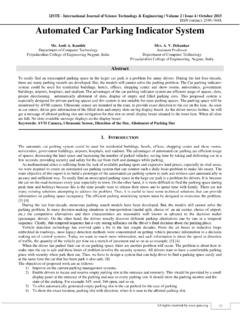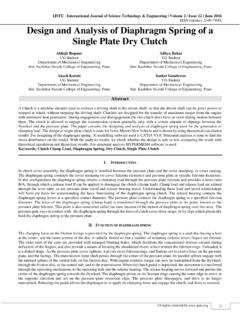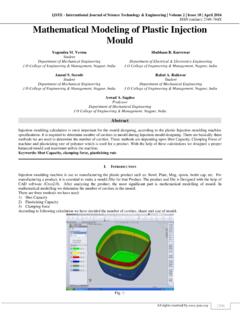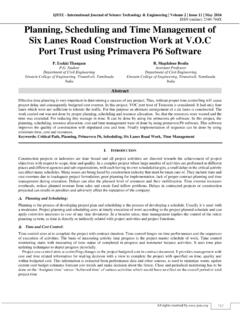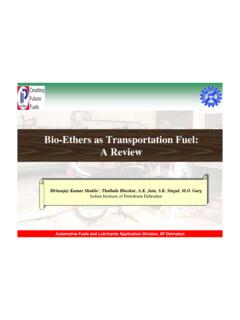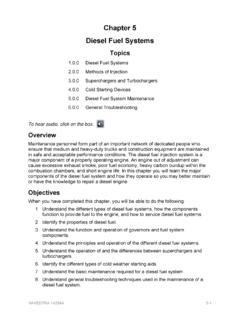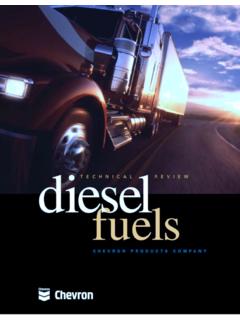Transcription of A Technical Review – Experimental Investigation on ...
1 IJSTE - International Journal of Science Technology & Engineering | Volume 2 | Issue 07 | January 2016 ISSN (online): 2349-784X All rights reserved by 1 A Technical Review Experimental Investigation on Performance of HCCI Combustion in diesel Engine with Gaseous fuel Natural Gas (CNG) Pawan Kishore Jha Prof. Vivek G. Trivedi PG Student Assistant Professor Department of Automobile Engineering Department of Automobile Engineering L D college of engineering, Ahmedabad L D college of engineering, Ahmedabad Nejal N. Patel Prof.
2 Shyam K. Dabhi PG Student Assistant Professor Department of Automobile Engineering Department of Automobile Engineering L D college of engineering, Ahmedabad L D college of engineering, Ahmedabad Abstract Alternate fuels have been used to fulfill the demand of fuel for engines used at various fields and also due to the decreasing petroleum fuel resources. Moreover the very low emissions norms have led to the experimentation, analysis and optimization of operating parameters of the engines run with these alternate fuels. Optimization of operating parameters to suit these alternate fuels have led to various new combustion techniques and one of these is HCCI.
3 HCCI technique is a promising combustion mode with high efficiency and low emissions of NOx and PM. This experiment s objective is to analyses the working of a single cylinder diesel engine under HCCI combustion mode using CNG, renewable fuel widely available from the agricultural wastes. The engine is run at its conventional mode and at HCCI mode with both diesel HCCI and also CNG HCCI. Keywor ds: ANN, ANFIS, Power Transformer, Regression, Performance, Backpropagation Algorithm _____ I. INTRODUCTION A. HCCI - Homogeneous Charge Compression Ignition Homogeneous charge compression ignition (HCCI) is an innovative technology.
4 In the HCCI engine, ultra-lean air- fuel mixture is highly compressed by the piston and ignited at the self-ignition temperature. Then, combustion occurs in the entire combustion chamber, and the combustion rate is very high, combustion is initiated by spontaneous auto-ignition of multiple sites under high temperature and high pressure conditions. As a result of ultra-lean combustion under a high compression ratio, high thermal efficiency and extremely low NOx emission are achieved. HCCI engines combine characteristics of both spark-ignited engines and compressed ignited engines.
5 Similar to spark ignited engines, HCCI uses a pre-mixed fuel -in-air charge, and similar to compressed ignited engines, the mixture is compression ignited. The diluted premixed charge facilitates a relatively uniform auto-ignition event rather than a non-premixed flame found in diesel engines, and thus HCCI engines can achieve fewer emissions of particulate matter. Homogeneous charge compression ignition, when applied to a gasoline engine, offers the potential for a noticeable improvement in fuel economy and dramatic reductions in NOx emissions as compared to the spark ignition operation.
6 Ultra low NOx levels and near zero soot emissions while maintaining high thermal efficiency, makes Homogenous Charge Compression Ignition (HCCI) combustion one of the most promising internal combustion engine strategies for the future. The advantages of HCCI combustion is due to its nature of very lean and premixed rapid combustion with high heat release rate and no flame front. HCCI combustion has high thermal efficiency because of ability to run with high compression ratios, no throttle loss, lean and almost constant volume combustion.
7 HCCI has the following advantages, High efficiency. Low NOx. Low particulate matter (smoke). Ability to operate on a variety of fuels. Low exhaust temperature. While the potential benefits of HCCI combustion are great, there are many difficulties need to be prevailed over. Producing high levels of CO and HC emissions, problems in cold start and reduced normal operating range of HCCI engines are some of these difficulties. One of the most important Technical challenges is to control the start of combustion (SOC) across the speed and load range of engine.
8 A Technical Review Experimental Investigation on Performance of HCCI Combustion in diesel Engine with Gaseous fuel Natural Gas (CNG) (IJSTE/ Volume 2 / Issue 07 / 001) All rights reserved by 2 Fig. : Comp arison of SI, CI and HCCI B. Literature Survey of HCCI Engine 1) Kathi Epping, Salvador Aceves, Richard Bechtold, John Dec, This paper describes the current state of HCCI technique listing the various barriers that are to be overcome before its implementation for commercial use. HCCI engines work on the principle of combustion of dilute premixed charge.
9 The charge burns volumetrically throughout the cylinder volume. In HCCI, the higher efficiencies are attained along with low emissions of PM (particulate matter) and NOx. There is no flame front propagation taking place and combustion is almost simultaneous throughout the chamber but the temperature attained is lower than that needed for NOx formation. HCCI engines are not suitable for Idle and heavy load conditions. Hence a dual mode engine is usually used where the engine runs as conventional SI or CI engine under idle and Heavy load conditions and switched to HCCI mode for low to mid load conditions.
10 HCCI is feasible only with the use of electronic control system and also the emissions of CO and HC are higher from an HCCI engine than the conventional engine though NOx and PM being lower in the emission. Lower fuel injection pressure can be used with HCCI. It has little sensitivity to fuel characteristics like lubricity and can be used on any hydrocarbon and alcohol liquid fuel as long as the fuel is vaporized and mixed with air. Dual fuel method in HCCI is proved to maintain a good combustion over a wide range of speed and load.


